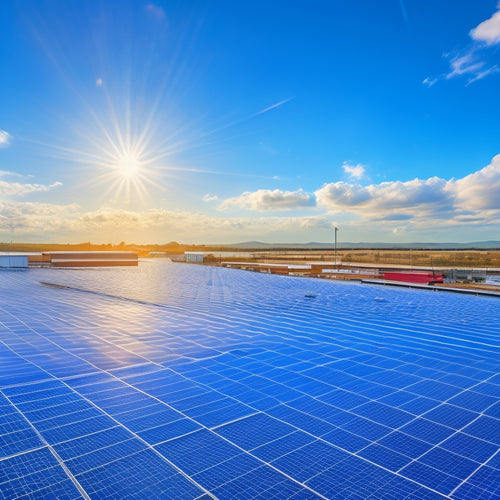
Energy Cost Savings Solutions for Commercial Properties
Share
Implementing energy cost savings solutions in your commercial property can greatly reduce operational costs and enhance your financial performance. Consider energy-efficient upgrades like modern HVAC systems, smart thermostats, and LED lighting to cut energy bills by 20% or more. Regular energy audits help identify inefficiencies, enabling you to streamline operations for better resource allocation. Plus, these investments typically yield quick payback periods and can even elevate your property's value. Adopting proactive measures today not only safeguards against future cost volatility but also positions your business for long-term success. Uncover additional strategies that could further optimize your energy management practices.
At a Glance
- Investing in energy-efficient equipment can reduce energy costs by 20% or more, with upgrades yielding long-term savings.
- Conducting energy audits identifies inefficiencies and potential savings, enhancing operational efficiency and reducing expenses.
- Implementing smart building technologies optimizes real-time energy consumption, resulting in substantial cost reductions and improved resource allocation.
- Energy-efficient properties attract higher rents and resale prices, enhancing overall property value and investment attractiveness.
- Financial incentives and tax credits support energy efficiency upgrades, maximizing savings and improving business profitability.
Proven ROI for Businesses
When you invest in energy cost savings solutions, you're not just reducing expenses; you're enhancing your operational efficiency.
By leveraging financial incentives and tax credits, you can further maximize your savings and make the shift to renewable energy more viable.
These improvements often translate to significant long-term financial benefits, increasing your bottom line.
Enhanced Operational Efficiency
Enhanced operational efficiency is essential for businesses looking to maximize their return on investment (ROI). When you streamline operations and reduce energy consumption, you're not just cutting costs—you're also enhancing productivity.
Conducting energy audits allows you to identify inefficiencies and uncover potential savings. By evaluating your current energy usage against operational benchmarks, you can pinpoint areas ripe for improvement.
Implementing energy-saving technologies and practices can lead to significant ROI. For instance, upgrading lighting systems or optimizing HVAC performance can drastically lower your energy bills.
And it's not just about immediate savings; more efficient operations often result in increased employee satisfaction and morale, leading to better performance.
Moreover, as you adopt these practices, you'll find that your ability to respond to market changes improves. A more efficient operation gives you the freedom to allocate resources where they're most needed, ultimately enhancing your competitive edge.
Long-Term Financial Benefits
Investing in energy cost savings solutions not only leads to immediate reductions in expenses but also yields considerable long-term financial benefits for businesses. When you adopt these sustainable investments, you're not just cutting costs; you're enhancing your financial forecasting capabilities.
You'll see how these solutions contribute to your bottom line over time, proving their return on investment (ROI) in undeniable ways. By integrating energy-efficient systems, you can markedly lower your operational costs, often achieving payback periods of just a few years.
This means the money you save can be reinvested in other areas of your business, encouraging growth and innovation. Additionally, as energy prices continue to rise, your proactive measures today will shield you from future financial volatility, ensuring your company remains competitive and resilient.
Moreover, many financial institutions recognize the value of sustainable investments, often providing incentives or favorable financing terms for businesses committed to energy efficiency. This not only enhances your financial strategy but also aligns your brand with eco-conscious values that connect with today's consumers.
Fundamentally, the long-term financial benefits you gain from energy cost savings solutions enable your business to thrive sustainably.
Reduced Operational Expenses
Upgrading to energy-efficient equipment can markedly lower your operational expenses, allowing you to allocate resources more effectively.
Additionally, implementing smart building technologies not only optimizes energy usage but also enhances overall operational efficiency.
By integrating energy conservation strategies, you can further enhance cost savings and improve your bottom line.
Energy-efficient Equipment Upgrades
Switching to energy-efficient equipment can lead to significant savings in operational expenses, often reducing energy costs by 20% or more. By investing in modern, energy-efficient systems, you're not just cutting costs; you're enhancing your property's value and appeal.
Conducting energy audits allows you to identify outdated equipment that's draining your resources. These audits provide clear perspectives into where upgrades will yield the most significant benefits.
Moreover, energy-efficient equipment typically has a longer lifespan than older models, meaning less frequent replacements and repairs. This translates to lower capital expenditures over time. You'll not only save money on energy bills but also enjoy the freedom that comes from reduced maintenance worries.
Upgrading to energy-efficient options can include HVAC systems, lighting, and appliances that operate more effectively, further decreasing your operational costs. The initial investment might seem intimidating, but the long-term savings and improved efficiency make it worthwhile.
Embracing these upgrades not only contributes to a sustainable future but also enables you to take control of your financial obligations. With energy-efficient equipment, you're not just saving money; you're investing in your property's future.
Smart Building Technologies
Smart building technologies are revolutionizing how properties manage energy consumption and operational expenses. By leveraging advanced tools like smart sensors and automated controls, you can track and optimize energy usage in real time. This not only cuts costs but also enhances the comfort and productivity of occupants.
Here's a quick look at how these technologies work:
| Technology | Benefits |
|---|---|
| Smart Thermostats | Optimize heating/cooling based on occupancy monitoring. |
| Energy Analytics | Analyze consumption patterns for informed decision-making. |
| Predictive Analytics | Anticipate energy needs, reducing waste. |
Cloud solutions and integration platforms allow seamless connectivity between IoT applications, enhancing the efficiency of your operations. With real-time data at your fingertips, you can make swift adjustments that lead to substantial savings over time.
Moreover, utilizing predictive analytics helps in forecasting energy demands and preparing accordingly. By adopting these smart technologies, you're not just reducing operational expenses; you're also stepping into a future where energy management aligns with your freedom to operate sustainably and efficiently. Embrace the power of smart building technologies today!
Key Benefits Overview
When you implement energy cost savings solutions, you not only reduce your operating expenses but also enhance your property value.
Home Energy Independence Systems can guarantee a minimum of 50% reduction in energy bills, providing a substantial financial advantage for commercial properties increased property value.
These financial benefits can greatly impact your bottom line, making your investment more attractive to potential buyers or tenants.
Reduced Operating Expenses
Reducing operating expenses is a critical goal for businesses looking to enhance their bottom line while maintaining productivity. One effective strategy involves conducting energy audits to identify inefficiencies in your property. By understanding your energy consumption patterns, you can make informed decisions that lead to significant savings.
In addition, taking advantage of utility incentives can further lower costs. Many utility companies offer programs designed to encourage energy efficiency upgrades. These incentives can provide financial support for implementing energy-saving technologies, allowing you to invest in solutions that benefit your operations and the environment.
Here's a quick comparison of potential savings from different energy-saving strategies:
| Strategy | Estimated Savings (%) |
|---|---|
| Energy Audits | 10-30% |
| LED Lighting Upgrades | 20-50% |
| HVAC Optimization | 15-40% |
| Smart Thermostats | 5-15% |
| Insulation Improvements | 10-20% |
Enhanced Property Value
Investing in energy-efficient solutions not only cuts costs but also greatly improves your property's value. By enhancing your property's aesthetics through modern, sustainable upgrades, you create an engaging visual appeal that attracts potential buyers and tenants.
A well-maintained, energy-efficient building stands out in a competitive market, making it an attractive investment opportunity.
Energy-efficient properties are increasingly sought after, as tenants and investors prioritize sustainability. This trend amplifies your investment attractiveness, as properties with lower operational costs and eco-friendly features often command higher rent and resale prices.
Furthermore, energy-efficient upgrades can lead to significant tax incentives and rebates, further enhancing your financial returns.
Additionally, by adopting green technologies, you signal a commitment to sustainability, which connects with environmentally conscious consumers. This alignment with modern values not only raises your property's status but also promotes long-term tenant retention.
Ultimately, improving your property's energy efficiency isn't just about saving on utility bills; it's a strategic move that amplifies your overall asset value.
Adopt these solutions, and you'll secure your property's position in a thriving, eco-friendly market.
Selecting Based on Energy Usage
To make informed energy-saving decisions, you need to understand your energy consumption patterns.
Utilizing tools like smart plugs and whole-house energy monitors can provide real-time data on your energy use, helping to pinpoint inefficiencies.
Analyzing usage data trends can reveal where you're wasting energy and how to allocate resources more effectively.
Understanding Energy Consumption Patterns
Understanding energy consumption patterns is crucial for making informed decisions about your energy usage. By conducting energy audits, you can identify where your property stands regarding energy efficiency. This process allows you to compare your usage against established consumption benchmarks, revealing areas for potential savings.
Here's a quick glance at how different factors can influence energy consumption:
| Factor | Impact on Energy Usage |
|---|---|
| HVAC Systems | Major energy consumers |
| Lighting | Varies by technology |
| Equipment Efficiency | Significant differences |
| Building Insulation | Reduces heating/cooling |
| Occupancy Patterns | Influences peak usage |
Analyzing Usage Data Trends
Analyzing usage data trends is essential for pinpointing energy inefficiencies and optimizing consumption. By leveraging usage analytics, you can identify patterns that reveal when and where energy is being wasted. This understanding enables you to make informed decisions about your energy strategy, allowing you to cut costs and improve operational efficiency.
You'll want to focus on collecting extensive data on your energy consumption. This data can help you forecast future consumption patterns, facilitating consumption forecasting that aligns with your operational needs. By understanding peak usage times and identifying anomalies, you can implement targeted energy-saving measures.
For instance, if you notice a spike in energy use during specific hours, it might be time to adjust your operations or invest in energy-efficient technologies. Regularly reviewing your usage data not only highlights inefficiencies but also helps you track the effectiveness of any changes you make.
In a world where energy freedom is paramount, analyzing usage trends guarantees that you're not just reactive but proactive. By taking control of your energy consumption, you can reveal significant savings and contribute to a more sustainable future.
Accept data analysis; it's your pathway to energy independence.
Lower Long-Term Maintenance Costs
Implementing predictive maintenance strategies can markedly reduce your long-term maintenance costs.
By anticipating equipment failures before they occur, you'll not only save on repair expenses but also minimize downtime.
This proactive approach leads to more efficient operations and ultimately enhances your bottom line.
Predictive Maintenance Strategies
Utilizing predictive maintenance strategies can greatly reduce long-term maintenance costs for your operations. By adopting predictive analytics, you can enhance maintenance scheduling and avoid costly downtime.
Condition monitoring plays a vital role; it allows you to track asset health in real-time, enabling failure prediction before issues escalate.
Implementing a strong data integration system guarantees that you have all relevant information at your fingertips, allowing for more effective asset management. By analyzing patterns in your equipment's performance, you can achieve performance optimization, maximizing efficiency and reducing unexpected failures.
Moreover, these strategies provide important observations for risk assessment, helping you allocate resources more effectively. With better resource allocation, you can prioritize maintenance tasks that truly matter, rather than relying on a reactive approach to maintenance.
Technology adoption is essential in this process; smart sensors and IoT devices enable you to gather and analyze data seamlessly.
Ultimately, predictive maintenance not only lowers your long-term maintenance costs but also enhances operational freedom, allowing you to focus on growth without the looming threat of unforeseen equipment failures.
Adopt these strategies and take control of your maintenance costs today.
Frequently Asked Questions
What Are the Most Common Energy-Saving Technologies for Commercial Properties?
You'll find that LED lighting, smart thermostats, and efficient HVAC systems greatly reduce energy usage. Conduct energy audits, improve insulation, implement building automation, and investigate renewable energy options and demand response strategies to maximize savings.
How Can I Assess My Building's Current Energy Efficiency?
To assess your building's energy efficiency, conduct energy audits and compare results against efficiency benchmarks. This evaluation reveals areas for improvement, enabling you to make informed decisions that enhance performance and reduce costs effectively.
Are There Government Incentives for Implementing Energy-Saving Solutions?
Many businesses benefit from federal rebates and tax credits when adopting energy-efficient technologies. You should investigate these incentives; they can considerably reduce upfront costs while promoting sustainability, enabling you to invest in your property's future.
What Is the Typical Payback Period for Energy-Saving Investments?
When evaluating payback periods, you'll find they typically range from three to seven years. Conducting a payback analysis helps you refine your investment strategies, ensuring you maximize returns while achieving your financial freedom goals.
How Do Energy-Saving Solutions Affect Tenant Satisfaction and Retention?
Implementing energy-saving solutions enhances tenant engagement and improves your property's reputation. Satisfied tenants appreciate sustainability efforts, leading to higher retention rates. You'll create a thriving community that values efficiency and environmental responsibility, securing long-term benefits for everyone involved.
Explore More
In the grand scheme of your business, energy cost savings solutions aren't just a drop in the ocean; they're the tide that can lift all boats. By investing in these strategies, you're not only slashing operational expenses but also securing long-term financial health. Think of it as planting seeds today for a bountiful harvest tomorrow. Adopt these solutions, and watch your profits grow while contributing to a more sustainable future. Your bottom line—and the planet—will thank you.
Related Posts
-

Top Eco-Friendly Camping Equipment for a Sustainable Adventure
When you're camping with the planet in mind, opt for eco-friendly gear like tents made from recycled materials and bi...
-

Solar Phone Chargers for Camping Essentials
Solar phone chargers are must-haves for your camping essentials, allowing you to stay connected while enjoying nature...
-

Commercial Solar Energy
As you consider powering your business with commercial solar energy, you'll uncover it offers a triple benefit: signi...


